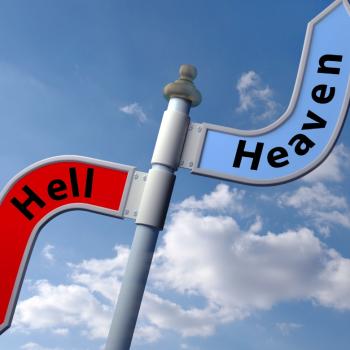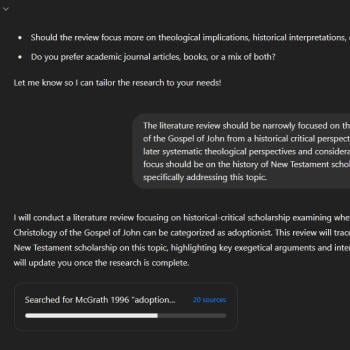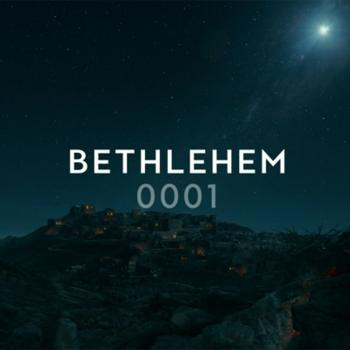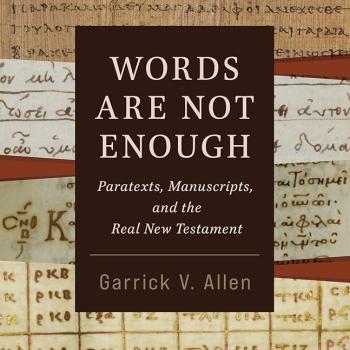For the Patheos Book Club centered on the book Do Jews, Christians, and Muslims Worship the Same God?
, we are taking a more dialogical approach. And since I read their blogs regularly, I thought I’d interact with John Morehead and Bob Cornwall, who’ve both posted their thoughts on the book already, since John in turn responds to others who wrote about the book earlier.
The book includes major contributions from scholars who represent both the present-day perspectives of Jews, Christians, and Muslims, as well as the academic study of the ancient traditions of those religions. Jacob Neusner and Baruch Levine represent the perspectives of Jewish scholars studying Judaism, Bruce Chilton a Christian studying Christianity, and Vincent Cornell a Muslim studying Islam. There is a concluding chapter summarizing and offering an overview by Martin Marty.
The book largely avoids simple “yes” or “no” answers. As one might expect, it is how the answer is qualified, explained, and explored that makes for interesting reading.
Baruch Levine starts the conversation off with an overview of Biblical texts and the historical developments and crossroads reflected in them. That monotheism itself has a history is an important aspect of interreligious dialogue between monotheistic faiths, one that is too often overlooked. The chapter ends with a reference to Psalm 145:18 as answering the question “Who holds the rights to the one, true God?” as follows: “All who worship him sincerely” (p.22). Recommendations for further reading is then provided.
Jacob Neusner begins his chapter by highlighting the issue of verisimilitude vs. authenticity – whether something that appears to be the same thing is necessarily the same thing in its essence. The remainder of the chapter focuses on the Rabbinic sources and their treatment of the minim – “heretics,” a group that included Christians. Neusner notes that, from the perspective of classical Judaism, no other religion is monotheistic, since the oneness of God is revealed in and inseparable from Torah (p.29). He concludes his exegetical survey by saying, “Judaic monotheism expounded by its normative sources cannot acknowledge the truth claims of any other monotheism, even though all monotheisms concur on the same theological logic.” Yet he also adds, “The very logic or monotheism governs and defines the outcome: all religious systems that affirm the unity of God necessarily speak of one and the same God.” And the position of Judaism cannot defy logic, and so the logic of monotheism, in Neusner’s opinion, trumps the outlook of the classical sources (p.52).
Bruce Chilton’s chapter seemed to me less helpful in some of its exegetical treatment, as there were passages I would have liked to see discussed yet which were not. But (as though to make up for it) his conclusion is every bit as compelling as the others in the volume. Chilton writes, “Each of the Abrahamic religions, while asserting that God is unique, also insists that its identification of God is uniquely true. That is why their God is one and not the same, and why believers need to acquire a taste for the fruits of difference” (p.83).
Vincent Cornell’s treatment of the subject seemed to me, as it did to Bob Cornwall, to be the most helpful. Cornell’s chapter focuses on what he calls the “Ethiopian’s Dilemma” in honor of a figure who was most likely Ella Seham, Negus of the Christian state of Aksum in what is today Ethiopia. Tradition says that the early Muslims fled there for safety, and that this ruler recognized that the teachings of the Muslims came from the same source as those of Christianity, the differences between the two being, according to one version, the length of a stick, and according to another, the width of a line he drew in the sand (pp.85-86). Yet the essence of Christianity seems to be focused in Christology and the doctrine of the Trinity, understood in ways that seem to be explicitly rejected by Islam. Cornell proceeds to focus on examples of historical and theological interaction between the traditions, seeking to do justice both to Islam’s explicit statements that the God Muhammad revealed is that worshiped by Jews and Christians, and its denunciations of the latter for not preserving the truth. Ultimately, “Islam is unique among the Abrahamic religions in opening the dor of salvation to its monotheistic rivals” (p.102). But a key distinction needs to be made between a question which is “(theo)-logically inappropriate” because of our limited human knowledge, namely whether the God of Judaism, Christianity, and Islam is the same, and the question of the extent to which the theologies of these religions are compatible or incompatible (p.103).
I noted with interest the ease with which Cornell said at one point, in reference to Qur’an 5:78, that “the Jesus that is referred to in this verse is Jesus the Islamic prophet, not Jesus Christ of Christianity” (p.107). It seems as though the identity of two depictions of a human being might be said to face the same issues as have been under discussion thus far. We may legitimately ask whether the portraits of Jesus in the Qur’an and the New Testament are compatible, just as we may ask whether those in the Gospels of Luke and John are compatible. But does that mean that there could be more than one “Jesus”?
Be that as it may, Cornell concludes that the question about the extent to which Christianity and Islam are compatible with respect to their teaching about God depends on the Christology of the Christians under discussion. Millard Erickson is provided as an example of an Evangelical theologian who says things about Jesus which are explicitly and utterly incompatible with the monotheistic affirmations of Islam. But other Christian theologians articulate their understanding of the Trinity and of Jesus differently.
The concluding chapter by Martin Marty helpfully sums up the discussion, offering quotes both from the preceding chapters and from elsewhere to bring the volume to a close. The most important thing Marty says, in my opinion, is that “superficial engagement with these issues is not helpful” (p.136). An attempt to provide a short and simple “yes” or “no” inevitably fails to do justice to the complexities and nuances of precisely what Jews, Christians, and Muslims have in common, and what separates us. Marty also highlights the typical role discussion of this subject often plays, leading it in potentially unhelpful directions: “Argument about who worships the right One God implicitly and even usually explicitly, amounts to the colloquial, “My God is better’n your God!” Such a claim satisfies the boaster but convinces no bystanders or seekers. The boast usually relies on claims that cannot be consistently verified and that come to be seen as affirmations about faith in an authority, for example, “My Books is better’n your Book” or “My pope is better’n your rabbi or imam.” Such “better’n” assertions are often related to efforts, which might be legitimate in other contexts, namely, to evangelize or proselytize. Or they can be revelatory of unpleasant and even dangerous psychological disorders” (p.141).
Bob Cornwall (in passing) and John Morehead both mention the topic of broader interreligious dialogue, which also gets passing mention in the book. I think that bringing religions into the picture which seem to have less in common with the Abrahamic faiths is actually useful, since taken on their own, the differences between Jews and Muslims might seem insurmountable. Yet in the context of a broader array of religious options, they might be seen from that different perspective as negligible. But more than that, the theological questions raised from that wider consideration relate directly to key issues in the conversation between Jews, Christians, and Muslims. If we consider Hinduism, for instance, the images of gods, and not just the sheer number of the latter, might seem to put Hindus beyond the pale from an Islamic perspective. But where then would Catholics be situated? And conversely, does anyone who speaks or thinks of God really manage to avoid idolatry? In what ways are statues or paintings worse than words and concepts, particularly when the latter can be literally “set in stone,” to say nothing of metaphorically? To the extent that modern Hindus often describe themselves as “monotheists,” believing in one ultimate reality, is the notion of Brahman too far afield to be considered the “same God,” and if so, why? Hindus were at times allowed under the umbrella of “people of the Book” – a decision that was always controversial, and was at least as much a pragmatic move as a theological one. But the mystics of the Sufi tradition often found they had much to talk about with Hindus mystics – at least as much, arguably, as the contributors to the book discussed in this post.
But returning, in order to conclude, to the monotheistic traditions and more specifically the Abrahamic ones, the key message of the book, which seems both practically and theologically sound, is that the affirmation of God’s unity means that there is no other god for anyone to actually worship. And so the real questions then become ones which are much more manageable. How important are the differences in conceptualization that exist between our traditions? What is it possible for us to do collaboratively across the boundaries of our traditions? What affirmations of the other traditions are beyond the pale of the acceptable from our standpoint, and why?
In addressing those topics, another key point that the book succeeded in making in several places is the diversity within each of these religious traditions. To say that Christians and Muslims or Jews have incompatible views of monotheism really depends on what sorts of Christians one is referring to and what their Christology is. Despite Cornell’s understandable statement that some sort of Trinitarianism is, from his perspective as an outsider a sine qua non of Christian identity, the truth is that from the earliest days of Christianity until the present, this has never been the case. There have always been at least some who self-identify as Christians but who either reject the doctrine of the Trinity outright, or understand it in ways that are closer to the monotheism of Jews or Muslims than to the borderline tritheism of some Christians. And this is important to mention, because it means that the questions about theological compatibility or incompatibility may cut across and through religions, uniting some from diverse traditions on each side of the divide.
For anyone interested in interreligious dialogue between the Abrahamic faiths, Do Jews, Christians, and Muslims Worship the Same God? is not just one but several important contributions to the conversation. I look forward to the discussions it will generate – not least in the blogosphere in the days to come as part of the current Patheos Book Club discussion!

















